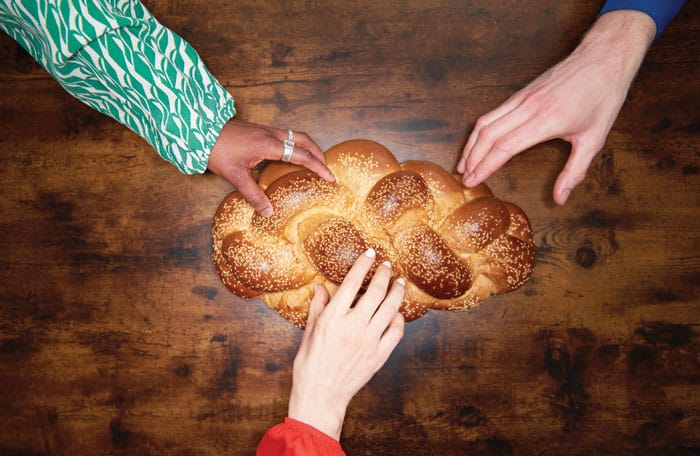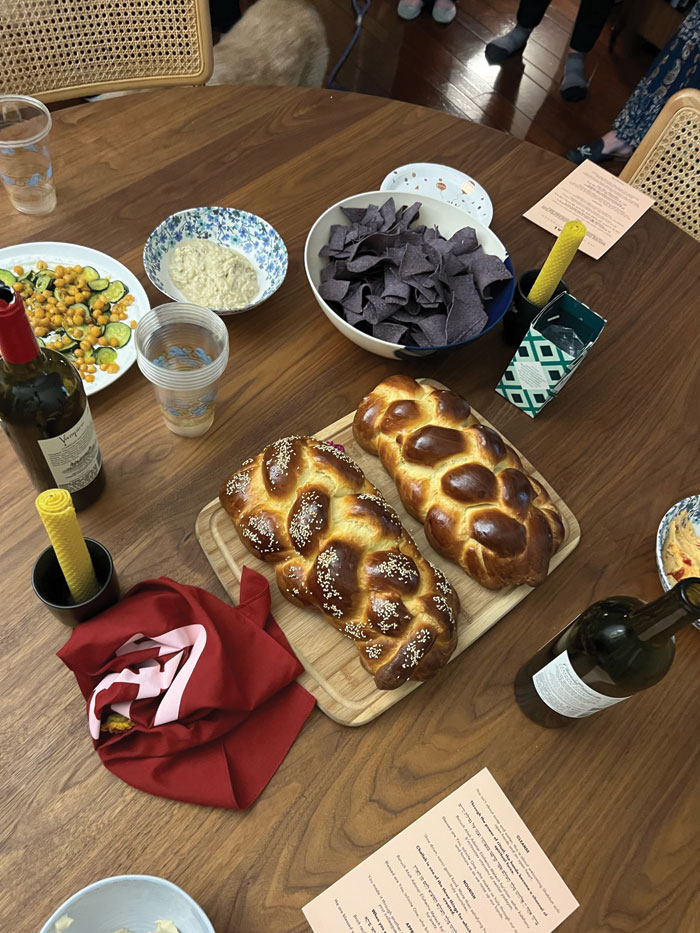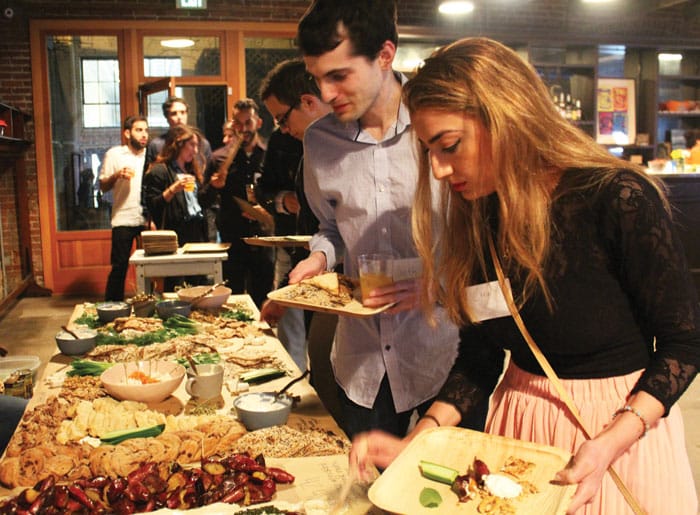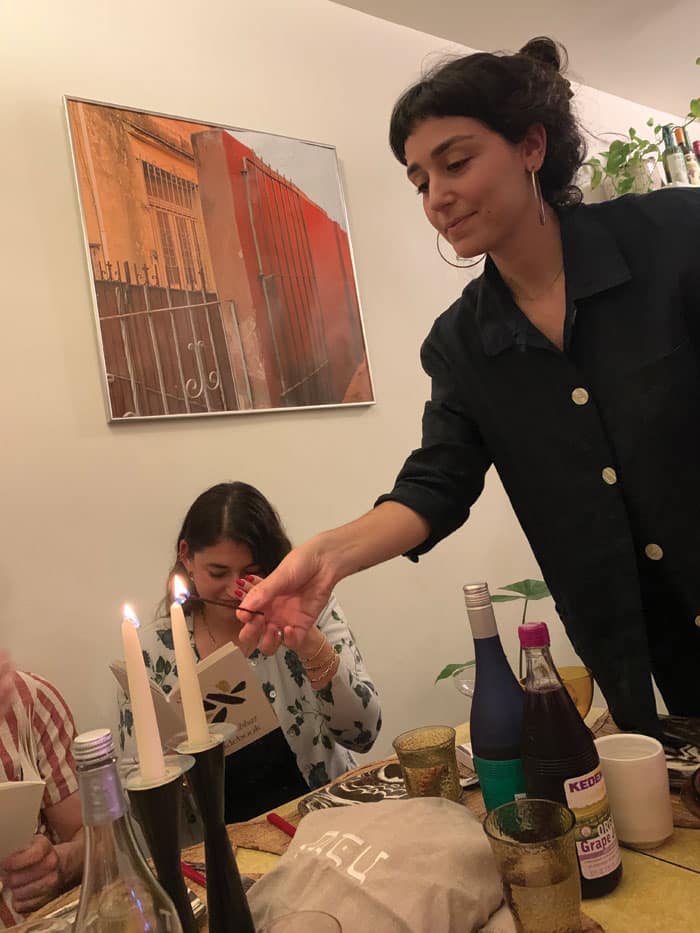 Tara Moore/Getty Images
Tara Moore/Getty Images Shabbat is a gift.
It’s an invitation to take time at the end of the week to unwind and connect with your family, your community, your religion. No matter what your Jewish background, sharing a Friday night Shabbat meal is like hitting the reset button.
OneTable is on a mission to help young adults (ages 21-39) establish and maintain a Shabbat practice by making Friday night dinners accessible, sustainable and valuable.
“I firmly believe that the best kinds of interpersonal connections happen around the Shabbat dinner table period,” Aliza Kline, founding president and CEO of OneTable, told the Journal. “I think there’s something magical and intentional about it.”
OneTable is like an Airbnb for Shabbat. The website connects hosts with guests and vice versa. There are a variety of options on the site, so guests can find a dinner that is near them, that fits their needs and has like-minded people.
“They might be vegan,” Kline said. “They might be Shomer Shabbat. They might want to talk about Israel. They might not want to talk about Israel. All of those different things.”
Over the past nine years, nearly 200,000 people have participated in OneTable; more than 90,000 Shabbat dinners have been posted by and for young adults. In Los Angeles, there have been more than 1,200 dinners and 4,000 unique people with nearly 9,000 seats.
In 2014, OneTable was started by two philanthropists. Now, it is supported by those same philanthropists in addition to family foundations, Jewish federations and individual donors, Kline explained. They wanted to find a way to engage and unite the next generation of Jewish young adults through a powerful experience, similar to the bonds created in birthright.
Plus, even before the pandemic, there was a well-documented epidemic of loneliness disproportionately affecting young adults.
“We want to create an opportunity for Judaism and Jewish community to be an antidote to that loneliness, and also to [create] some stickiness to Jewish culture, religion and tradition.” -Aliza Kline
“There was Pew Research, initially in 2013, and then reinforced in 2020, about the ways in which young adults were feeling much more disassociated from Jewish life,” Kline said. “We want to create an opportunity for Judaism and Jewish community to be an antidote to that loneliness, and also to [create] some stickiness to Jewish culture, religion and tradition.”
Shabbat, Kline said, creates a literal place to come together. All you need is a location.
Mickey Karbal, who identifies as Conservadox and lives in Studio City, has been hosting at OneTable for a couple of years. Whereas he used to do smaller dinners with close friends, for almost a year he has been hosting large dinners, sometimes with 50 to 60 people.
“I’ve had people who were not so aligned with their Jewish roots, so to speak, come up to me and tell me how important these events are, so much so that they become hosts on OneTable, as well,” Karbal told the Journal.
Karbal grew up Modern Orthodox, so Shabbat was always important in his family.
“There was a dinner every Friday night without fail that would eventually end in a game of Monopoly, or just a bunch of boys running around the house and causing havoc,” Karbal said. “That said, no kid really wants to be told what to do and I was no different. I started disliking all the rules that came with Shabbat, and began to ‘rebel’ from the halachot.”
Now that he’s a bit older, Karbal views Shabbat as a sacred time that he looks forward to all week. “It has become associated in my mind with relaxation, no work, no exercise,” he said. “Just family, friends and love.”
For his OneTable experiences, Karbal cultivates a no-pressure space.
“I happen to work in the music industry so I’d say a good chunk of people that show up are in the biz,” he said. “But I never really want Shabbat to be a networking thing. I think that’s corny.”
There’s no TV in Karbal’s apartment, so they play anything from Nirvana to Paul McCartney to Miles Davis on his little bluetooth speakers.
“Before dinner, which I usually cook or have someone help me cook, I give a speech to a room full of 20 to 40 people,” he said. “Maybe [it’s] something about the week or how I’m feeling in general. Then we all get to know each other. And at some point we always end up doing karaoke in my music studio.”
OneTable also provides support to help the hosts create an inviting and beautiful experience for their guests.
“We offer nourishment credit, which is really financial support in the form of an online gift card,” Kline said. “That might help someone buy the prepared foods to elevate their meal or groceries or a tablecloth.”
They provide coaching on everything from how to cook a chicken and get it out of the oven on time to how to properly say the blessings. Plus, there are articles, recipes and resources on OneTable.org.
They provide coaching on everything from how to cook a chicken and get it out of the oven on time to how to properly say the blessings. Plus, there are articles, recipes and resources on OneTable.org.
“We have a whole new campaign called, ‘How I Shabbat,’ which gives different young adult voices with different interpretations of the Shabbat blessings, for example,” she said. “So the young adults can see themselves in it and can feel empowered to do it themselves.”

(Photo by Katherine Shifke)
An executive assistant in the entertainment industry, Carrie DiGregorio, who is Reform and lives in Hancock Park, hosted her first OneTable Shabbat last month.
Right before everything shut down in March 2020 she had been invited to a OneTable Shabbat, which was canceled due to rising COVID cases.
“[Earlier this year], one of my friends and I were talking about wanting to feel more connected to our community here in L.A. and to connect more to our spiritual sides,” DiGregorio told the Journal. “She mentioned she was interested in hosting a Shabbat and I remembered … that there was an organization who could help us with that. Thus the pieces all came together and I signed up to host with OneTable.”
DiGregorio’s family was never very religious, so she didn’t start celebrating Shabbat until college when she worked as a graphic designer for Tulane Hillel. The other Hillel employees encouraged her to come to Shabbat dinners, and it quickly became one of her favorite Friday events.
“I just loved seeing everyone that I loved and having a great meal and great conversation to end a hard week,” she said. When DiGregorio, who’s originally from Baltimore, moved to L.A. she says she fell out of practice celebrating Shabbat.
DiGregorio and her friend agreed to host a Shabbat at least once a month. She made the challah, her friend made the main course and guests brought a few sides and desserts.
“We tried to keep the rituals that were meaningful to us: the lighting of the candles, blessing of the wine, blessing of the challah and setting an intention for what we wanted everyone to get out of this meal.” – Carrie DiGregorio
“We tried to keep the rituals that were meaningful to us: the lighting of the candles, blessing of the wine, blessing of the challah and setting an intention for what we wanted everyone to get out of this meal,” she said. “I’m really glad to have this opportunity to reconnect with my community and my spiritual side.”
OneTable has made hosting Shabbat feel less intimidating. And, even though DiGeorgio is new to the organization, she is moved by their mission. It has inspired her to create her own traditions without feeling like they aren’t Jewish or traditional enough.

(Photo courtesy OneTable)
“[OneTable] eliminates the barrier to entry for Jews and non-Jews alike to join in this celebration of rest,” DiGregorio said. “There are so many great Jewish traditions that I think everyone, regardless of creed, can enjoy. I think everyone can use a little shabbat in their life. Modern life does not revolve around rest and if I can encourage those around me to take a step back on Friday nights and make time for friends, food and rest I want to spread that message to everyone I can!”
During the pandemic, people were so desperate to feel connected that they celebrated Shabbat with their pod, roommates, families (because they moved back home), by themselves or on Zoom.
OneTable did not allow virtual Shabbat dinners until the pandemic. The whole point was to use technology to give people an IRL (in real life) experience. However, once the pandemic hit, they wanted to make virtual available right away.
They also lowered the minimum number of people required at a OneTable dinner. Before the pandemic, it was required to have at least five people: the host plus at least four others. The ideal number of people per dinner was eight and the average number was 12 to 14. The new minimum was one person.
“We had people who were immunocompromised or were living by themselves, who learned to create a beautiful Shabbat dinner for themselves,” Kline said. “We created a solo Shabbat guide.”
They also encouraged couples to use the platform.
“You know, all those stories about couples living at home and trying to navigate their relationship,” Kline said. “Shabbat [could] provide a punctuation to the week, so they would use the platform to invite each other: “Dear Beloved, Please come be my guest at Shabbat dinner.”
Previous to the pandemic, OneTable provided financial support only once a month, a policy they have since eliminated. They did not want to create any additional barriers for connection and Jewish celebration and togetherness. Within one month, they went from having 200 to 250 dinners a week to 400.
The number of dinners grew overall from about 9,000 a year in 2019 to 17,000 in 2020. And the numbers have continued to grow.
Kline explained how young adults started repeating more and intensifying their experience. Shabbat became a way for them to cope through this journey.
Now, while there are still some who go virtual — during the pandemic virtual dinners never made up more than 30% of dinners in a given week — the focus continues to be on in-person interpersonal connections.
The virtual option tends to be used by affinity groups. Los Angeles has a huge cross section of people, but that’s not the case everywhere. It’s easier for people who have very specific needs or connections (Jews of Color, LGBTQ and others, for example) to find one another on Zoom, as opposed to locally.
“There may not be enough plant-based food Jewish Shabbat aficionados in Tallahassee, Florida, but they could join a Zoom call with other people who are interested in plant-based food for their Shabbat dinner experience if it’s national,” she said. “One of my favorite virtual Shabbat dinners we did was for deaf Jews, and because they could use ASL in Zoom. We just hadn’t even thought about that.”
Kline explained that there are a few different young adult populations that engage with OneTable. For some, Shabbat is new; they come to OneTable as a guest. Others grew up with Shabbat, but got away from the rituals and want to re-embrace it. The third population is those who are making an intentional decision to find something meaningful.
“In all cases, they’re young adults who are forming their own identity and relationship with Judaism,” Kline said. “We call it OneTable, because it’s very unifying, very collective, and very engaging. But it’s very personalized also. We are helping people do what they’re inclined and desiring to do, but are not able to do it without our help.”
Sarah Fanchon Cohen, change management consultant/facilitator/producer in Pico-Robertson, attended OneTable dinners when she was living in her hometown of Chicago from 2016 to 2018. She started hosting at OneTable in Los Angeles 2020.
“My family always hosted Jews and non-Jews alike for Shabbat and holidays, and I love to continue that tradition,” Cohen told the Journal. “I find I often connect even more deeply with my Jewish roots when sharing the customs and traditions with my wider, and often non-Jewish, community.”
Shabbat is timely, but also timeless. This ancient ritual provides a contemporary solution for young people who want to have conversations, while forming community and deep connections.
You can think of almost anything going on in the world, and you will find a lot of young people who are affected by it, whether it’s climate change, social justice or the rising tide of antisemitism.
“The weeks that the Kanye West ugliness was in the news every minute, our numbers shot up,” Kline said. “People say, ‘I want to come together for Shabbat to talk about what’s going on in the world and I just want to be amongst my people. I want to be in that kind of safe environment.”
Others just say, “I really need Shabbat this week.” And this is true of all ages and populations, not just the young people who are using OneTable to explore their own Jewish identity.

OneTable host Aliana Turkel is a Jewban (Jewish and Cuban) freelance photographer in Echo Park. Born and raised in Miami, Florida, Turkel practices Reform Judaism.
During quarantine in 2020, when Turkel was craving ritual, and wanted to incorporate some sort of sanctity into life, Turkel jumped on the bandwagon of pandemic bread baking with a twist: baking challah on Shabbat.
“At the time I was living in an old Victorian home in DTLA that had been converted into several apartments,” Turkel told the Journal. “Fortunately my roommate and I were very close with the other tenants. Every Friday, when folks in the house would smell my challah in the oven, people would file into our apartment to break bread and celebrate the Sabbath.”
During Passover 2022 Turkel became a OneTable host.
“Working with OneTable has been a true blessing,” Turkel, who felt pretty shaky hosting dinners at first, told the Journal. “Between their Shabbat guides and nourishment resources, I’ve learned how to reconnect with my Judaism and how to help others connect,” Turkel said. “And OneTable has sparked this domino effect around me. I’ve had so many friends (Jewish and non-Jewish) come to me about wanting to start integrating Shabbat into their lives. It’s SO beautiful!”
Turkel believes what OneTable offers Jews in their 20s and 30s is priceless.
“What is unique and especially appealing about OneTable is that they guide you to find ritual that resonates with your Jewish practice rather than offering prescriptive ways to celebrate,” Turkel said. “I’ve had countless calls and email exchanges with OneTable’s field managers (shoutout to Naomi, Abbie, Dani and Talia) about how to craft a Shabbat experience that feels true to me and my practice.”
Of course, OneTable is hardly the only group promoting the Friday night Shabbat experience. On college campuses across the nation, for example, Hillels and Chabads have made Friday night a centerpiece of their programming. And in the wake of the pandemic, many synagogues are using the Friday night meal to help their communities reconnect.
Indeed, for the Jewish community, Shabbat is the gift that keeps on giving. Kline feels like Shabbat is her oxygen. “It helps me sustain,” she said.
“The way that we have seen young adults embrace [Shabbat] has been just outstanding. And totally gratifying for those of us who love community, food, connection and Judaism.” – Aliza Kline
“The way that we have seen young adults embrace [Shabbat] has been just outstanding,” Kline said, “And totally gratifying for those of us who love community, food, connection and Judaism.”
How OneTable Works
Go to OneTable.org and click, “Get Started.” It takes you through a very sweet user journey, so that you feel like a little taste of Shabbat.
The interface asks a few questions in order to curate and share resources about how you can elevate your own Shabbat practice. After you answer those questions, it literally will say, “Hi, Nice to meet you.”
Then, you can choose between “I’d like to find a dinner to attend” or “I’d like to host a dinner.”
If you’re ready to host a dinner, you’ll be taken to an online application.
“We want to know a bit more about you, your motivation and how we can help elevate your experience,” Kline said. “Because we’re going to give you a micro-grant, we want to have accountability there.”
Once accepted, when you go to create a dinner on the website, you are given the option to pick what type of dinner you would like to have (virtual, private, open, etc.), along with minimum number of people, time, date, etc.
If you want to attend a dinner, you will see the dropdown of cities where dinners are taking place. There are about 600 cities across the country. Some dinners are open to anybody, for others you need to request a seat (you go through a vetting process with the host). Then there are some dinners that are completely private.
“That’s something that we have always allowed, but it became even more important during the pandemic, and potentially even more with rising anti-semitism,” Kline said. “We don’t advertise people’s addresses in a way that is unsafe. Some people may intentionally [just invite] friends and friends of friends, and [use] a private URL to RSVP.”
Jake’s Perfect Challah
From OneTable friend and board member Jake Cohen’s cookbook: “JEW-ISH: A Cookbook: Reinvented Recipes from a Modern Mensch.”
“I love serving up one ornate challah at Shabbat, but if you’re keen on serving two for tradition, you can easily split this dough in half before dividing it into balls, rolling, and braiding,” Jake says. “They can be baked on the same half sheet pan—just be sure to space them at least 4 inches apart.”
Prep Time: 40 minutes, plus 2 hours 30 minutes proofing Time
Cook Time: 35 minutes
Ingredients:
1 cup water, heated to 115°F
½ cup (100g) granulated sugar
1 (¼-oz) packet active dry yeast (2¼ tsp)
6 tbsp vegetable oil
¼ cup honey
4 large eggs
5½ to 6 cups (745g to 810g) all-purpose flour, plus more for dusting
2 tsp kosher salt
1½ tsp assorted seeds, such as sesame, fennel, poppy, nigella, and/or cumin, for garnish
Flaky sea salt, for garnish
1. In the bowl of a stand mixer fitted with the whisk attachment, mix the warm water and 2 tablespoons of the sugar to dissolve, then sprinkle the yeast over the top. Let stand until foamy, 5 to 10 minutes. Add the remaining 6 tablespoons sugar, 4 tablespoons of the vegetable oil, honey, and 3 of the eggs, then whisk on medium speed until incorporated.
2. Switch to the dough hook. Add 5½ cups flour and the salt to the mixture in the bowl and, beginning on low speed and gradually increasing to medium, knead until a smooth, elastic dough forms, 3 to 4 minutes. (Your dough will be tacky but shouldn’t be sticky. If it’s sticky, mix in additional flour, a few tablespoons at a time, until tacky.) Transfer to a lightly floured work surface with floured hands and continue to knead by hand, dusting with flour as needed, until a very smooth ball forms, another 3 to 5 minutes. (Alternatively, if you make this dough entirely by hand, it will require about 10 minutes of kneading on a clean work surface after incorporating the flour.) Grease a medium bowl and your hands with the remaining 2 tablespoons of vegetable oil and add the dough ball, turning gently to coat. Cover with plastic wrap or a kitchen towel and set aside in a warm place until doubled in size, 1½ to 2 hours.
3. Transfer the dough to a clean work surface and divide into 6 equal pieces. Roll each into a long rope, about 18 inches in length and slightly thicker at the center and thinner at both ends. Lay out all the ropes vertically, then link the top of each rope and pinch together to seal, tucking the sealed end under itself slightly.
4. Take the outer two ropes and cross them over each other to switch places, crossing the rope from the right under the rope from the left. Take the farthest rope on the right and cross it over to be in the middle (with 3 ropes on the left of it and 2 ropes on the right). Then, take the second rope from the left and cross it all the way to the far right. Now, take the farthest rope to the left and move it to the middle (with 2 ropes on the left of it and 3 ropes on the right). Take the second rope from the right and cross it all the way to the far left. Repeat this process until there are no more ropes to braid, then pinch the ends and tuck them under the end of the challah. Using your hands, carefully transfer the challah to a parchment-lined half sheet pan, placing it on a diagonal.
5. Beat the remaining egg and brush liberally on the challah. Let the challah rise again, uncovered, until doubled in volume, about 1 hour.
6. Preheat the oven to 350°F.
7. Brush the challah again with the remaining beaten egg, then sprinkle with the seeds and a heavy pinch of flaky salt.
8. Bake, rotating the pan halfway through the cooking time, for 35 to 40 minutes, until the challah is golden brown and has reached an internal temperature of 190°F. Remove from the oven and let cool completely before slicing. Serve the challah the same day you bake it.
For more on braiding, as well as additional Shabbat recipes from OneTable, go to OneTable.org/2021/02/22/jew-ishlaunchshabbat/























 More news and opinions than at a Shabbat dinner, right in your inbox.
More news and opinions than at a Shabbat dinner, right in your inbox.